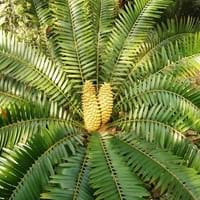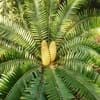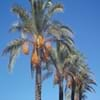Life Span
Perennial
Annual
Type
Palm or Cycad
Perennial
Origin
South Africa
South Africa
Types
Not available
Shasta Daisy
Gloriosa Daisies
Painted Daisy
Pyrethrum Daisies
Number of Varieties
Not Available
Habitat
Upland savannas
gardens, Grassland
USDA Hardiness Zone
9-13
10-11
Sunset Zone
H1, H2, 22, 23, 24
8, 9, 12, 13, 14, 15, 16, 17, 18, 19, 20, 21, 22, 23, 24
Habit
Arching/Fountain-shaped
Clump-Forming
Flower Color
Not Available
White, Yellow, Blue, Purple, Orange, Pink, Magenta
Flower Color Modifier
Bicolor
Bicolor
Fruit Color
Yellow, Orange, Orange Red
Not Available
Leaf Color in Spring
Green, Dark Green
Green, Blue Green
Leaf Color in Summer
Dark Green
Green, Blue Green
Leaf Color in Fall
Dark Green
Green, Blue Green
Leaf Color in Winter
Dark Green
Light Green
Leaf Shape
Long linear and narrow
Arrowhead
Plant Season
Spring, Summer, Fall, Winter
Spring, Summer, Fall
Sunlight
Partial Sun
Full Sun
Growth Rate
Very Slow
Fast
Type of Soil
Loam, Sand
Loam
The pH of Soil
Acidic, Neutral
Neutral
Soil Drainage
Well drained
Well drained
Bloom Time
Not Available
Late Spring, Early Summer, Summer, Late Summer, Early Fall, Fall
Tolerances
Light Frost
Drought
Where to Plant?
Container, Ground, Pot
Ground, Pot
How to Plant?
Seedlings
Seedlings, Stem Planting
Plant Maintenance
Low
Medium
Watering Requirements
Needs less watering
Allow soil to be completely dry in between waterings, It cannot sustain wet-feet, Keep the ground moist but not water-logged, Water in morning to avoid prompting diseases, Water twice a day in the initial period
In Summer
Lots of watering
Lots of watering
In Spring
Moderate
Moderate
In Winter
Average Water
Average Water
Soil pH
Acidic, Neutral
Neutral
Soil Type
Loam, Sand
Loam
Soil Drainage Capacity
Well drained
Well drained
Sun Exposure
Partial Sun
Full Sun
Pruning
Remove damaged leaves, Remove dead branches, Remove dead leaves
Cut or pinch the stems, Prune regularly, Remove deadheads
Fertilizers
All-Purpose Liquid Fertilizer
All-Purpose Liquid Fertilizer
Pests and Diseases
Cycad weevils, Root Pathogen
Red blotch
Plant Tolerance
Light Frost
Drought
Flower Petal Number
Not Available
Single
Foliage Texture
Bold
Medium
Foliage Sheen
Glossy
Not Available
Attracts
Not Available, pollinators
Bees, Butterflies
Allergy
Not Available
Not Available
Aesthetic Uses
Cottage Garden, Showy Purposes
Beautification, Bouquets, Showy Purposes
Beauty Benefits
Not Available
Not Available
Environmental Uses
Air purification
Air purification
Medicinal Uses
Not Available
Cold, Cough, Stomach pain
Part of Plant Used
Bark, Pine
Flowers
Other Uses
Traditional medicine
Showy Purposes, Used as Ornamental plant
Used As Indoor Plant
No
Yes
Used As Outdoor Plant
Yes
Yes
Garden Design
Feature Plant, Mixed Border, Rock Garden / Wall, Tropical
Bedding Plant, Container, Cutflower, Foundation, Groundcover, Hanging Basket, Mixed Border, Rock Garden, Wall
Botanical Name
Encephalartos lebomboensis
OSTEOSPERMUM
Common Name
Lebombo Cycad
African daisy or Blue-eyed Daisy
In Hindi
Lebombo Cycad
अफ्रीकी डेज़ी
In German
Lebombo Palmfarn
African Daisy
In French
Lebombo Cycad
marguerite africaine
In Spanish
Lebombo cícadas
margarita africana
In Greek
Lebombo Cycad
Αφρικανική μαργαρίτα
In Portuguese
Lebombo Cycad
africano margarida
In Polish
Lebombo Cycad
Gerbery
In Latin
Lebombo Cycad
African primula
Phylum
Cycadophyta
Anthophyta
Class
Cycadopsida
Magnoliopsida
Order
Cycadales
Asterales
Family
Cycadaceae
Asteraceae
Genus
Encephalartos
Osteospermum
Clade
Not Available
Angiosperms, Asterids, Eudicots
Tribe
Not Available
Calenduleae
Subfamily
Not Available
Asteroideae
Number of Species
Not Available
Properties of Lebombo Cycad and African Daisy
Wondering what are the properties of Lebombo Cycad and African Daisy? We provide you with everything About Lebombo Cycad and African Daisy. Lebombo Cycad has thorns and African Daisy doesn't have thorns. Also Lebombo Cycad does not have fragrant flowers. Lebombo Cycad has allergic reactions like Not Available and African Daisy has allergic reactions like Not Available. Compare all the properties and characteristics of these two plants. Find out which of these plant can be used as indoor plant. If you are interested to decorate your house and garden, find out aesthetic uses, compare them and select the plant which will beautify your surrounding. Along with beautification, try comparing medicinal and edible uses of Lebombo Cycad and African Daisy and you can choose the plant having best and most benefits.
Season and Care of Lebombo Cycad and African Daisy
Season and care of Lebombo Cycad and African Daisy is important to know. While considering everything about Lebombo Cycad and African Daisy Care, growing season is an essential factor. Lebombo Cycad season is Spring, Summer, Fall and Winter and African Daisy season is Spring, Summer, Fall and Winter. The type of soil for Lebombo Cycad is Loam, Sand and for African Daisy is Loam while the PH of soil for Lebombo Cycad is Acidic, Neutral and for African Daisy is Neutral.
Lebombo Cycad and African Daisy Physical Information
Lebombo Cycad and African Daisy physical information is very important for comparison. Lebombo Cycad height is 300.00 cm and width 300.00 cm whereas African Daisy height is 15.20 cm and width 45.70 cm. The color specification of Lebombo Cycad and African Daisy are as follows:
Lebombo Cycad flower color: Not Available
Lebombo Cycad leaf color: Green and Dark Green
African Daisy flower color: White, Yellow, Blue, Purple, Orange, Pink and Magenta
- African Daisy leaf color: Green and Blue Green
Care of Lebombo Cycad and African Daisy
Care of Lebombo Cycad and African Daisy include pruning, fertilizers, watering etc. Lebombo Cycad pruning is done Remove damaged leaves, Remove dead branches and Remove dead leaves and African Daisy pruning is done Cut or pinch the stems, Prune regularly and Remove deadheads. In summer Lebombo Cycad needs Lots of watering and in winter, it needs Average Water. Whereas, in summer African Daisy needs Lots of watering and in winter, it needs Average Water.





